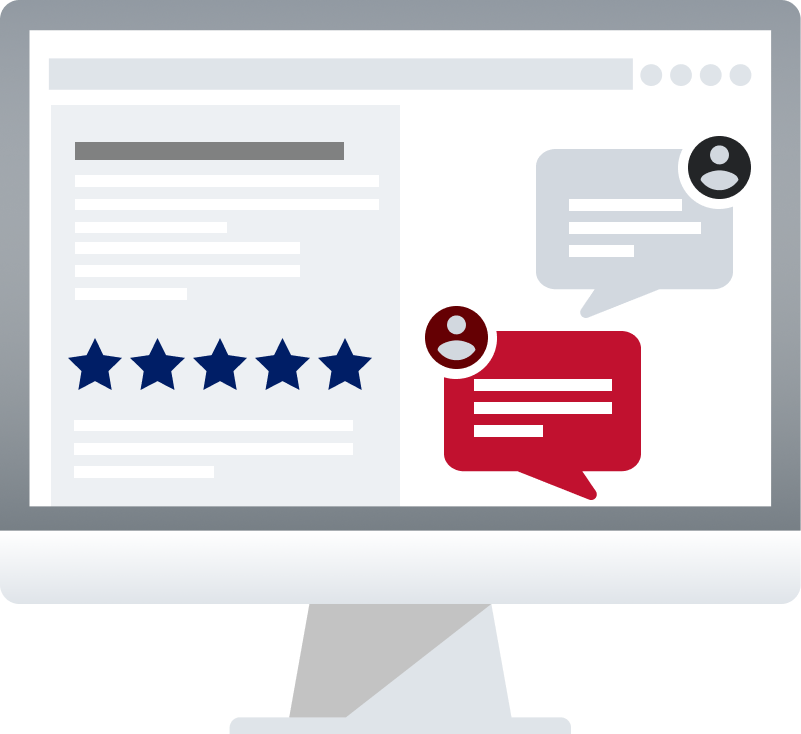Market research surveys consistently show that upwards of a whopping 97% of consumers read reviews before patronizing a local business. As a key component of overall reputation, reviews are more critical than ever for community banks, credit unions and financial brands. Indeed, they influence the ability to attract and retain depositors, cross-sell customers into new product lines, engage commercial clients, and retain clients over crucial life stages when their client value increases. Here, we’re doing a deep dive on online reviews to give you all the context you need to proactively monitor and manage them. Here are 10 things you need to know to maximize reviews.
1. Establish a systematic review monitoring process.
Reviews can happen at any time and through various online platforms, including Facebook, Google, Yelp, and others, making it especially important to stay on top of them as they come in. To do so, establish a system for regularly monitoring various online review platforms for inbound reviews. Note that a monitoring tool can be a big help here; more on that later.
2. Respond promptly and professionally.
Responsiveness says a lot about your organization, and can reflect well (or poorly) on your organization, depending on your approach. In the case of reviews, you’ll want to create a system that allows you to respond to reviews within a reasonable timeframe, preferably 24 to 48 hours after the review is submitted. It’s important to respond thoughtfully and professionally. Be sure to address concerns, demonstrate empathy, and show your commitment to providing excellent customer service. When an issue needs to be resolved offline, use your response to direct the customer to another avenue for working through the issue. When reviews are positive, be gracious and appreciative.
3. Personalize responses.
Tailor responses to public reviews to the specific person and information noted in the review. Use the reviewer’s name if available, and avoid generic or automated responses, which can reflect poorly on your brand. Personalization shows that you genuinely care about customer feedback, take it seriously, and are generally appreciative of your customers.
4. Maintain a positive tone.
Regardless of the customer’s feedback or the tone they take, always maintain a positive and constructive tone in your response. Always avoid getting defensive or engaging in arguments. Instead, focus on finding a resolution and showcasing your willingness to address concerns and commitment to continuous improvement in your products, services, and processes.
5. Take the conversation offline.
If a review requires further discussion or resolution, it’s typically a good idea to offer to take the conversation offline. Provide contact information or invite the reviewer to reach out to a designated representative to address their concerns privately and in a more personalized manner. This keeps negative, irrelevant, and confidential feedback from being on full display and is best for both customers and your organization.

6. Ask customers for their feedback.
Rarely will customers (even very happy ones) take the time to leave a review, unless they are personally asked to do so. The best way to get great reviews, is to make the ask. Be sure to time your ask for when customers have just had a great experience, and make it as easy as possible for them to submit a review. Remember that every extra step creates friction that can cause happy customers to stop or give up, even if they definitely want to submit a review. Provide simple links and instructions from the individuals they work with. A consistent influx of positive reviews can help counterbalance any negative feedback and enhance your overall online reputation.
7. Create other avenues for feedback.
Look for ways to solicit feedback from your customers outside of formal review processes through surveys and customer service interactions. This allows your organization to surface constructive feedback that you can correct before it becomes an issue and inherently leading to better online products, better service, and better online reviews.
8. Monitor information in listings.
Reviews are sometimes aggregated across platforms; this is the case in search results, making information like branch locations, ATM locations, hours, and other key stats important to keep updated and accurate in your online listings. In fact, some platforms prompt users to verify things like hours, location, and other data to ensure accuracy, but if users are actually inaccurate, your online listing information can become inaccurate too. This creates issues that can lead to bad reviews, making it important to suppress inaccurate information swiftly and continuously.
9. Leverage social media listening and keyword monitoring.
Social media listening and monitoring tools allow financial brands to track mentions, keywords, and hashtags related to their institution, products, and services. Monitoring social media commentary across all major channels lets financial brands proactively address misinformation, negative sentiment, or emerging trends that have the potential to impact customer behavior or overall reputation. What’s more, staying informed and engaged in social media conversations can also help financial brands identify opportunities to improve customer experience.

10. Use a comprehensive review management and monitoring tool.
If you’re managing reviews, responses, and logistical information across your online listings and digital channels by hand, technology can help! Social Assurance works with financial brands of all shapes and sizes, helping them deploy a centralized review management software that makes it easy to efficiently and accurately manage reviews and even generate more of them. With a centralized dashboard, real-time notifications, task assignments that ensure prompt follow-ups, and review generation functions. The platform even offers sophisticated tracking mechanisms that keep them on your radar based on a number of pertinent categories (e.g. rating, sentiment, specific keywords, and other criteria). Meanwhile, competitor analysis functionality that lets your financial brand monitor and compare your bank’s online reputation against competitors, helping you benchmark performance and stay competitive.
Get Started
This guide is part of our latest series on listings and reputation management, helping you understand the complexities of digital listings and master your financial brand’s online presence. Interested in learning more about listings and reputation management? Social Assurance can help. We work with community banks and credit unions and the major associations that support them to provide compliant, user-friendly solutions and services that save time, streamline compliance and record-keeping, and mitigate risk across every major channel.
Contact us at info@socialassurance or use the form below to learn more.


